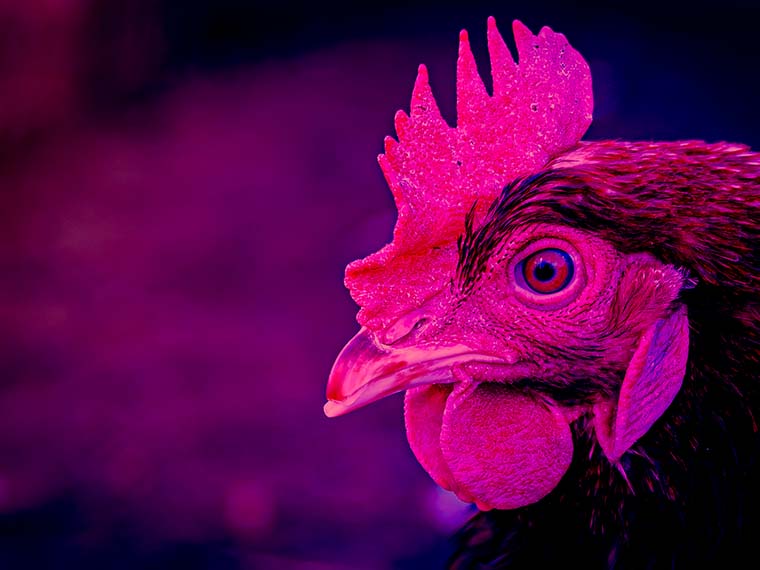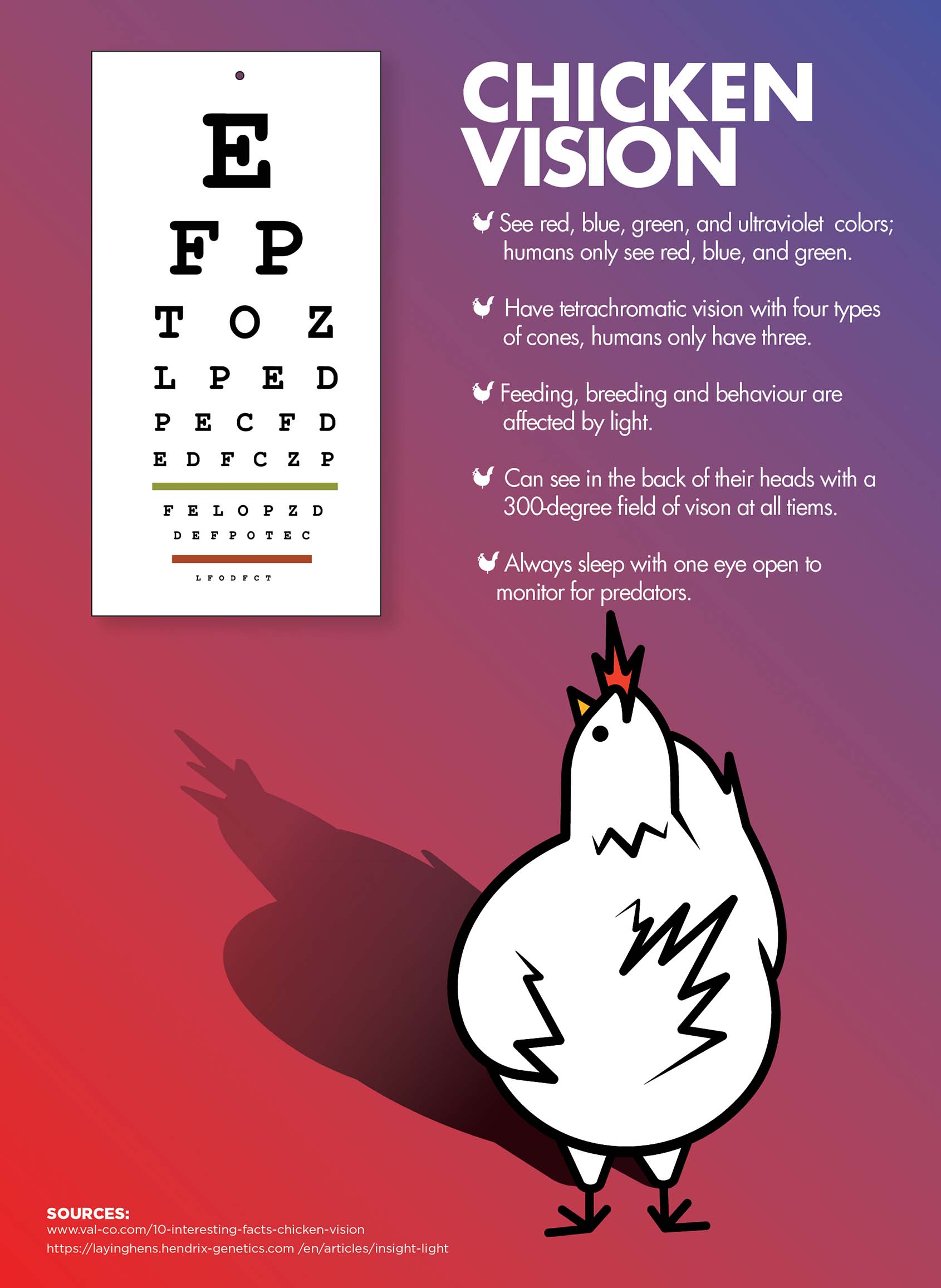Science That Illuminates
MAFES researchers investigate alternative lighting for laying hens
By: Vanessa Beeson
The information presented on this page may be dated. It may refer to situations which have changed or people who are no longer affiliated with the university. It is archived as part of Mississippi State University's history.
Chickens see light and color better than humans. In fact, when MAFES researchers studied laying hens under blue-LED light, everything was visible to the birds while the scientists had to be equipped with special lights to move around and collect the data they needed.
"We couldn't see anything in front of us, so we had to wear special light pendants to see clearly enough to conduct the research," said Dr. Pratima Adhikari, assistant professor in the Department of Poultry Science and MAFES scientist.
The experiment was part of a two-year project that studied how blue- and red-LED light impacted the growth and production potential of laying hens.
Chickens' superior propensity to seeing color better than humans stems from the fact that not only do they have more cones than us, they also have an extra type of cone that allows them to see ultraviolet light. Cones are the photoreceptors that process color. Since light passes through a chicken's skin and skull through the pineal and pituitary glands, they also see light better. It's not surprising that light and color can have a significant impact on a chicken's development so Adhikari and her team dug in to learn more.
The scientists studied how blue- and red-LED light regimens impacted the performance, behavior, egg quality, and hormonal concentrations during the growing and laying phases of layer hens. The research sought to determine how the treatments impacted factors such as growth, egg production, and stress.
"We wanted to see the effect of the blue-LED light in the pullet phase, while the chickens were still growing and reaching reproductive maturity. During that phase, we were most interested in how that particular light impacted growth and reproductive hormonal concentration.
After that, we were interested in how red-LED light during the layer phase affected production performance and egg quality," she explained.
During the project's entire duration, the team also assessed how both blue- and red-LED light affected bird behavior and stress response.
"We explored how the alternative lighting impacted hen wellbeing and health, and whether different lighting was a stressor or changed their behavior in addition to impacting growth and production," she said.
The project was a partnership between MSU, Xiant Technologies, Inc., the company who produced the lights, and Cal-Maine Foods. The researchers studied a thousand Hy-Line W-36 birds raised in a cage-free environment at the Poultry Research Unit of the MAFES H.H. Leveck Animal Research Center. In the first trial, 500 layer hens were split across two identical rooms. The first room was equipped with blue-LED lights from week one to week 18 and red-LED lights from week 19-31 for 24 hours a day. The control room was equipped with standard-LED lights administered from 23 hours a day in the beginning to 12 hours a day toward the trial end. The second trial was repeated in the exact same manner with the rooms being switched as the only difference.
The team found that blue light was beneficial during the pullet phase as birds immersed in the indigo hue had a significantly higher body weight from one to 18 weeks of age. Adhikari also said the birds exposed to the blue-LED light began laying eggs at a mean age of 17.35 weeks compared to 19.07 weeks for the birds raised under standard lighting.
"Interestingly, by the end of the sixteenth week, we began seeing eggs being laid earlier by the chickens bathed in blue light. The blue light was adding a lot of body weight, which is very important when chickens are young. They grew faster, so they experienced reproductive maturity earlier," Adhikari explained.
During the production phase, a higher relative egg yolk percentage was observed in the red-LED light environment.
"A higher yolk albumen ratio could be beneficial for the food industry by targeting production of high yolk percentage to produce eggs for products that require egg yolk as a main ingredient such as mayonnaise or eggnog. The yolk also has cosmetic, nutritional, and medical uses," Adhikari noted.
The alternative lighting didn't have an impact on health or stress.
"Our experiment found that serum melatonin levels and serum corticosterone levels were not affected by light difference," Adhikari said.
Ishab Poudel, then a master's student in the Department of Poultry Science, assisted on the work. He has since graduated and is pursuing a poultry science doctoral degree with an anticipated graduation date of May 2023. Poudel was excited to see how alternative light might be utilized to enhance growth and production.
"Lighting technology has evolved significantly with LEDs as the newest lighting source offering better energy efficiency, a longer lifespan, and the ability to change light color within a poultry house," Poudel said. "Light color is gaining significance in poultry growth, especially in laying hen growth and production. It's interesting to see that light can change the bird's physiology so much and show results with increased growth rate and increased yolk size at certain stages."
Poudel, who found a passion for poultry while working for an international nongovernmental organization focused on using livestock to address hunger and poverty, is most excited about how the research can potentially help the industry.
"Working with chickens is always exciting. The thing that gives me the most joy in this work is that we will be contributing to the industry and the scientific community and that our research will provide some insight for both of these communities," he said.
The project was funded by MAFES Special Research Initiative, or SRI, grant. The work was also part of the hatch project of the USDA NIFA (MIS-329280). Collaborators include Dr. Mary Beck, professor and head of the Department of Poultry Science; Dr. Aaron Kiess, former MSU poultry science professor; and Dr. Jan DuBien, associate professor in the MSU Department of Mathematics and Statistics.
We explored how the alternative lighting impacted hen wellbeing and health, and whether different lighting was a stressor or changed their behavior in addition to impacting growth and production.
Dr. Pratima Adhikari
Behind the Science

Pratima Adhikari
Assistant Professor
Education: B.S., DVM, B. V.Sc and A. H., Tribhuvan University; M.S., Animal Nutrition, University of Manitoba; Ph.D., Poultry Science, University of Georgia
Years At MSU: 4
Focus: layer nutrition, gut health, management, disease challenge models
Passion At Work: In layers, nutrition and lighting are two pillars. I am trying to understand their relationship in egg laying hens and how we, the scientist, can answer our questions on how these two go together well. I am trying to see if we can help US egg industry and producers to decide the effectiveness of new lighting technology before they are ready to adopt it on a large commercial scale in their farms.


